Olympus Stylus Zoom 115 User Manual
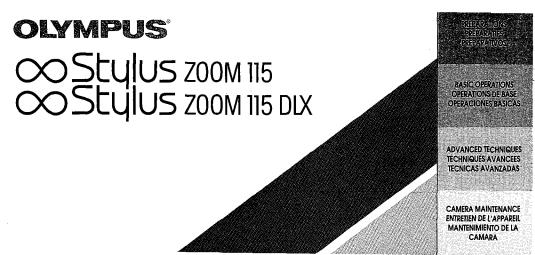
INSTRUCTIONS
Before using your camera, read this manual carefully to ensure correct use.
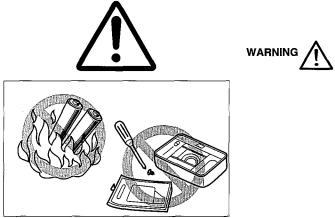
Thank you for purchasing an Olympus camera. Before you start to use your new camera, please read these instructions carefully to obtain optimum performance and a longer service life from the unit.
Indicates circumstances under which mishandling resulting from ignoring this symbol could result in personal injury or property damage.
KEEP THE BATTERIES AWAY FROM FIRE.
NEVER TRY TO DISASSEMBLE, RECHARGE, OR
SHORT CIRCUIT BATTERIES.
NEVER ATTEMPT TO DISASSEMBLE THE CAMERA;
IT CONTAINS A HIGH-VOLTAGE CIRCUIT.
IF THE INTERNAL PARTS OF THE CAMERA ARE
EXPOSED DUE TO DROPPING OR DAMAGE,
REMOVE THE BATTERIES IMMEDIATELY TO
PREVENT FURTHER USAGE.
IN CASE OF MALFUNCTION, CONSULT YOUR
NEAREST OLYMPUS DEALER OR OLYMPUS
SERVICE CENTER.
2
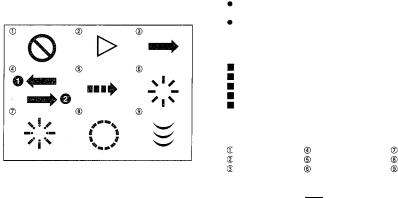
Before using your camera, read this manual carefully to ensure correct use.
We recommend that you take test shots to get accustomed to your camera before taking important photographs.
MAIN FEATURES Built-in 38mm ~ 115mm 3X zoom lens.
Quartzdate or time imprinting. Weatherproof.
Remote control (optional).
Versatile, easy-to-use functions include spot metering, night scene, as well as various flash modes.
Symbols used in this manual:
Incorrect |
Operation order |
Indicator blinking |
Next operation |
Automatic operation |
Attention |
Manual operation |
Indicator on |
Depress halfway |
Pay particular attention items in the instructions enclosed in boxes 

Product shown in the illustrations may be slightly
different from the unit. |
3 |

PREPARATIONS
BASIC OPERATIONS
Names and functions of parts............................................. |
6 |
Viewfinder display/LCD panel................................................... |
8 |
Diopter adjustment.................................................................... |
9 |
Using the strap/soft case........................................................... |
9 |
Outline of operations .......................................................... |
10 |
Loading the battery................................................................... |
13 |
Checking the battery................................................................. |
14 |
Points to remember................................................................... |
15 |
Loading the film ................................................................. |
17 |
Taking pictures............................................................................... |
20 |
Using the Focus lock .......................................................... |
25 |
After Shooting................................................................................. |
27 |
Unloading the film .............................................................. |
28 |
4

ADVANCED TECHNIQUES
CAMERA MAINTENANCE
Taking panorama pictures*..................................................... |
29 |
Using the flash modes......................................................... |
33 |
Auto Flash ........................................................................ |
35 |
Red-eye Reducing Flash...................................................... |
36 |
OFF (Flash Override)......................................................... |
37 |
Fill-In Flash (Forced Activation)........................................... |
38 |
Night Scene Flash........................................................ |
39 |
Red-eye Reducing Night Scene Flash Mode............ |
40 |
Spot............................................................................ |
41 |
Selftimer..................................................................... |
43 |
Remote Control (optional) ......................................... |
44 |
Correcting the data............................................................... |
46 |
Printing the date and time ................................................ |
48 |
Questions and answers......................................................... |
49 |
Care and storage .............................................................. |
50 |
Caring for your weatherproof camera................................ |
53 |
Battery handling ............................................................... |
55 |
Remote Control (optional) handling .................................. |
57 |
Troubleshooting............................................................... |
58 |
Specifications................................................................... |
65 |
*DLX model only |
5 |

NAMES AND FUNCTIONS OF PARTS
Shutter release button (p. 16.) Zoom lever (p. 21.)
Zooms in — telephoto. Zooms out — wide-angle.
Viewfinder Strap eyelet Light sensor* Lens barrier
Autofocus windows* Lens*
Selftimer Indicator
LCD panel (Date/time indicator) (p. 8.) Flash*
Selftimer/remote control button (p. 43/44.) Flash mode button (p. 33.)
Do not soil as this can cause blurred pictures. Wipe clean with a soft cloth.
6
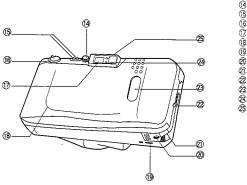
Diopter adjustment dial (p. 9.)
Quartzdate mode buttons (p. 46.) Panorama switch* (p. 29.)
Viewfinder (p. 8.) Back cover
Mid-roll rewind button (p. 28.)
Tripod socket
Battery compartment cover Back cover release (p. 17.) Film window
Green lamp
Orange lamp
*DLX model only
7
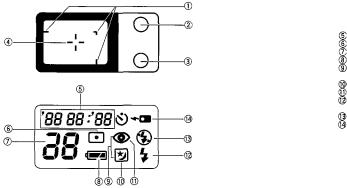
VIEWFINDER DISPLAY/LCD PANEL
Viewfinder Display
 Close-up correction marks At a close distance, your subject must be positioned within the close-up correction marks.
Close-up correction marks At a close distance, your subject must be positioned within the close-up correction marks.
 Orange lamp
Orange lamp
Lights when the flash is ready to fire.
Blinks while the flash is recharging.
 Green lamp
Green lamp
Lights when the subject is in focus.
Blinks when the subject is not in focus.
 Autofocus mark
Autofocus mark
Position your subject within the autofocus mark.
LCDPanel
Date/time indicator Spot (p. 41.)
Exposure counter (p. 17.) Battery check (p. 14.) Red-eye Reducing Night Scene Flash (p. 40.) Night Scene Flash (p. 39.)
Red-eye reducing flash (p. 36.) Fill-In Flash
(Forced Activation) (p. 38.) Off (Flash Override) (p. 37.) Selftlmer/remote control
(p. 43/44.)
8 |
Note: The LCD panel does not actually display all indications |
simultaneously as shown. |
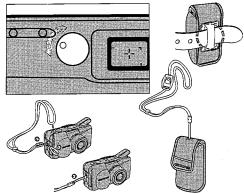
DIOPTER ADJUSTMENT
To Adjust the Viewfinder to Compensate for Near-and-Far-sighted Vision
Turn the diopter adjustment dial until the viewfinder display becomes clear.
Turn to the right if you are far-sighted or to the left if you are near-sighted.
USINGTHESTRAP/SOFTCASE
Attaching the strap.
The soft case can also be carried on a belt.
9
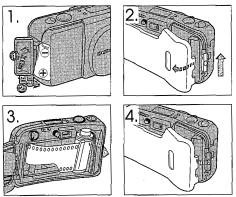
OUTLINE OF OPERATIONS
Basic Shooting Procedures
1. Load a battery (p. 13).
2.Open the back cover (p. 17).
3.Load the film (p. 17). (UseofISO400filmisrecommended.)
4.Close the back cover. The film automatically advances to the first frame (p. 19).
10
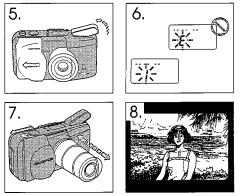
5. Open the lens barrier until you feel a click (p. 19).
6.. Make sure the exposure counter on the
LCD panel reads  (p. 19).
(p. 19).
7. Press the zoom lever for telephoto or wide-angle photography (p. 21).
8. Placetheautofocusmarkonthe subject you want to photograph
(p. 22).
11
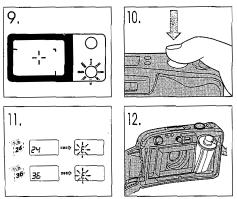
9.Depress the shutter release button halfway to make sure the green lamp lights (p. 22).
10.
11.
12.
Depress the shutter release button fully to take a picture (p. 23).
When the film reaches the end, it will automatically rewind (p. 28).
Open the back cover to remove the rewound film (p. 28).
12
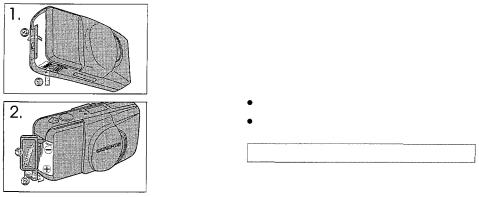
LOADING THE BATTERY
1. Close the lens barrier. Push OPEN  to open the battery compartment cover
to open the battery compartment cover  .
.
2.Insert the new battery correctly as shown and close the battery compartment cover tightly.
Use a 3 V lithium battery (DL 123A, CR123A, or equivalent.)
About 15 rolls of film can be used with one new battery. (p. 49)
Read "Battery Handling" on page 55.
13
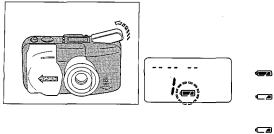
CHECKING THE BATTERY
Open the lens barrier as shown until you feel a click. Check the remaining battery power.
Display |
Meaning |
|
|
lights (and turns off |
Battery is OK. |
automatically). |
You can shoot. |
|
|
blinks and other |
Battery power is low and |
indicators on the LCD panel |
battery should be replaced. |
are displayed normally. |
|
|
|
blinks and other |
Battery is dead and should |
indicators on the LCD panel |
be replaced immediately. |
go out. |
|
|
|
Note: Keep spare battery on hand when going on a long trip or a wedding or when using the camera in cold weather. Adjust the data every time the battery is replaced.
14
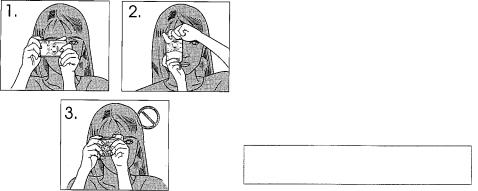
POINTS TO REMEMBER
Hold the Camera Correctly.
1.Correct.
Hold the camera firmly with both hands while keeping elbows at sides to prevent the camera from shaking.
2.Correct.
In the vertical position, hold the camera with its flash positioned at the top.
3.Incorrect.
Caution:
Keep your fingers and the strap away from the lens, autofocus windows and flash. (p. 6).
15
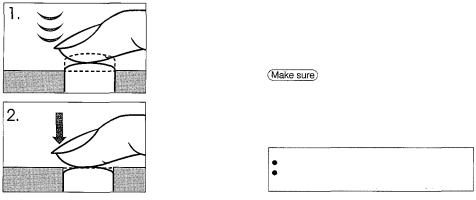
Proper Shutter Release.
Practice before loading the film.
1. Depress the shutter release button halfway to lock the focus.
|
The green lamp next to the viewfinder lights. |
2. |
Depress the shutter release button fully |
|
to release the shutter and take the |
|
picture. |
|
Cautions: |
|
Press the shutter release button gently. |
|
Avoid shaking the camera when pressing the |
16 |
shutter release button to prevent blurry pictures. |
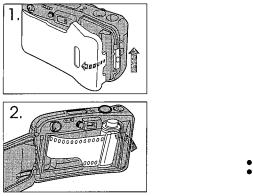
1.
2.
LOADING THE FILM
Slide the back cover release upward to open the back cover.
Do not touch the inside of the camera, especially the lens. If there is dust or dirt on the lens, remove it with a blower brush.
Insert the film cartridge, making sure the film is lying flat.
Notes:
Use of ISO 400 film is recommended.
When using non-DX-coded film, ISO 100 is automatically set.
17
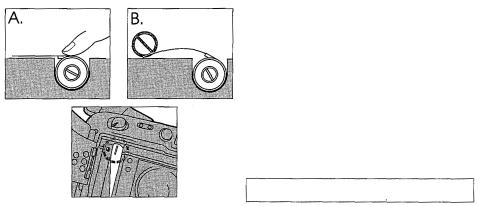
A. Correct.
Make sure the film is lying flat before closing the back cover.
B. Incorrect.
If the film is not lying flat as shown, the film may not advance to the first frame.
|
Caution: |
18 |
Do not touch the plastic parts near the take-up spool. |
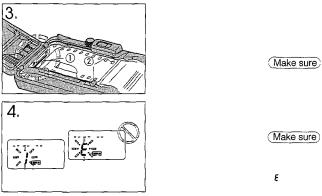
3. Align the film leader with the mark  , and close the back cover.
, and close the back cover.
The film automatically advances to the first frame.
The film does not overlap any of the positioning guides shown on the left.
shown on the left.
4. Openclick. the lens barrier until you feel a
The exposure counter on the LCD panel reads
Note:
If blinks in the exposure counter, as shown on the left,
the film is improperly loaded. Reload the film. |
19 |
|
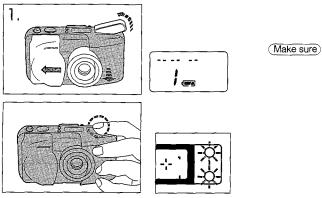
TAKING PICTURES
1. Openclick. the lens barrier until you feel a
The lens extends slightly, the flash pops up, and the LCD panel activates.
When the flash is held down, the two indicators next to the viewfinder blink. The camera will not activate,
The display also goes out.
Release the flash to reactivate the camera.
20
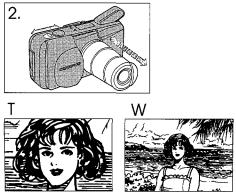
2.Aim the camera at your subject. Use the zoom lever for telephoto or wide angle photography.
How to Use the Zoom Lever:
Telephoto:
Pull the lever to the "T" side to zoom in.
Maximum telephoto focal length: 115 mm
Wide angle:
Push the lever to the "W" side to zoom out.
Maximum wide-angle focal length: 38 mm
21
